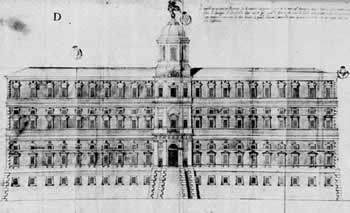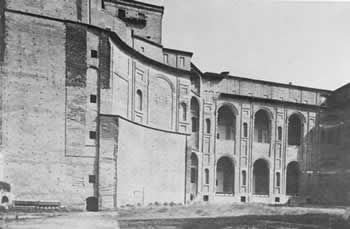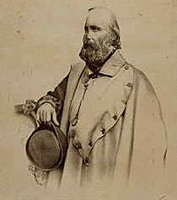
Palazzo Farnese (Piacenza)
Encyclopedia


- For other palaces with this name, see Palazzo Farnese (disambiguation)Palazzo Farnese (disambiguation)Palazzo Farnese can refer to a series of edifices built by the Italian Farnese noble family:*Palazzo Farnese, Rome*Palazzo Farnese, Caprarola*Palazzo Farnese, Piacenza...
.
Palazzo Farnese is a palace
Palace
A palace is a grand residence, especially a royal residence or the home of a head of state or some other high-ranking dignitary, such as a bishop or archbishop. The word itself is derived from the Latin name Palātium, for Palatine Hill, one of the seven hills in Rome. In many parts of Europe, the...
in Piacenza
Piacenza
Piacenza is a city and comune in the Emilia-Romagna region of northern Italy. It is the capital of the province of Piacenza...
, northern Italy
Italy
Italy , officially the Italian Republic languages]] under the European Charter for Regional or Minority Languages. In each of these, Italy's official name is as follows:;;;;;;;;), is a unitary parliamentary republic in South-Central Europe. To the north it borders France, Switzerland, Austria and...
.
History
This large partly constructed palace is located on the banks of the River Po in the city of PiacenzaPiacenza
Piacenza is a city and comune in the Emilia-Romagna region of northern Italy. It is the capital of the province of Piacenza...
in Northern Italy. In 1556, Ottavio Farnese, Duke of Castro and of Parma
Parma
Parma is a city in the Italian region of Emilia-Romagna famous for its ham, its cheese, its architecture and the fine countryside around it. This is the home of the University of Parma, one of the oldest universities in the world....
, also became Duke of Piacenza and initially set up his court there. Ottavio decided on a residence in the city possibly because he could feel more secure due to the presence of a Spanish garrison.
The palace was commissioned by Ottavio's wife, Margaret of Austria, daughter of Emperor Charles V
Charles V, Holy Roman Emperor
Charles V was ruler of the Holy Roman Empire from 1519 and, as Charles I, of the Spanish Empire from 1516 until his voluntary retirement and abdication in favor of his younger brother Ferdinand I and his son Philip II in 1556.As...
. The new edifice was erected over a former fortress built by the Visconti
House of Visconti
Visconti is the family name of two important Italian noble dynasties of the Middle Ages. There are two distinct Visconti families: The first one in the Republic of Pisa in the mid twelfth century who achieved prominence first in Pisa, then in Sardinia where they became rulers of Gallura...
in 1352, part of which can still be seen.
An initial design was made by Francesco Paciotto, from Urbino
Urbino
Urbino is a walled city in the Marche region of Italy, south-west of Pesaro, a World Heritage Site notable for a remarkable historical legacy of independent Renaissance culture, especially under the patronage of Federico da Montefeltro, duke of Urbino from 1444 to 1482...
, and in 1558, the architect Giacomo Barozzi da Vignola, better known as Vignola, was brought in to revise the designs. Vignola had already been commissioned to design the Villa Farnese
Villa Farnese
The Villa Farnese, also known as Villa Caprarola, is a mansion in the town of Caprarola in the province of Viterbo, Northern Lazio, Italy, approximately 50 kilometres north-west of Rome...
at Caprarola
Caprarola
Caprarola is a town and comune in the province of Viterbo, in the Lazio region of central Italy. The village is situated in a range of volcanic hills known as the Cimini Mounts....
(Latium
Latium
Lazio is one of the 20 administrative regions of Italy, situated in the central peninsular section of the country. With about 5.7 million residents and a GDP of more than 170 billion euros, Lazio is the third most populated and the second richest region of Italy...
) for Cardinal Alessandro Farnese, another member of the family. Vignola had to take Piacotto's design into account but significantly revised the design which was presented to the patrons in 1561. The drawings are for a vast palace on a scale paralleled only by the Vatican Palace in Italy; the rectanglar plan is circa 111 metres by 88 metres. The building works were entrusted to Giovanni Bernardo Della Valle, Giovanni Lavezzari and Bernardo Panizzari (Caramosino). The actual construction, however, made up only less than a half of Vignola's original project and lacked many of the planned architectural features; missing elements include part of the exterior surrounding walls, the main façade modelled on the ancient triumphal arch and with a large tower, and a theater in the large inner courtyard. The expenditure of such a large palace plus the political machinations of the Piacentine nobility may have caused Ottavio not to complete the building and instead move his court from Piacenza to Parma. The construction of this partly built palace was completed in 1602, under Duke Ranuccio I
Ranuccio I Farnese, Duke of Parma
Ranuccio I Farnese reigned as Duke of Parma, Piacenza and Castro from 1592. A firm believer in absolute monarchy, Ranuccio, in 1594, centralised the administration of Parma and Piacenza, thus rescinding the nobles' hitherto vast prerogative...
.

Ducal Chapel
The Ducal Chapel (Cappella Ducale or Cappella Grande) was used by the family for its religious rites. It is a hall on a square plan, turned into an octagon by the introduction of four apses at the corners. The sides have the same length as the chapel's height up to the hemispherical dome. The chapel is decorated with lilies from the Farnese coat of arms and Mannerist masks portraying angels. Other symbols referring to the Ducal family such as the unicornUnicorn
The unicorn is a legendary animal from European folklore that resembles a white horse with a large, pointed, spiraling horn projecting from its forehead, and sometimes a goat's beard...
, starfish, dolphin
Dolphin
Dolphins are marine mammals that are closely related to whales and porpoises. There are almost forty species of dolphin in 17 genera. They vary in size from and , up to and . They are found worldwide, mostly in the shallower seas of the continental shelves, and are carnivores, mostly eating...
s and turtles, appear in the large frieze.
Museums and exhibitions
- In the Archaeological Museum is the famous 'Piacenza Liver', an Etruscan bronze of a liver with Etruscan writing that was possibly used for haruspicy or divination by the reading of animals entrails.
- The Gallery or Pinacoteca is housed in the so-called "Duchess Apartments", on the first floor. It contains paintings from the 16th-17th centuries once belonging to the Dukes' collections. The most important artwork is the Madonna with the Young St. John, by Sandro BotticelliSandro BotticelliAlessandro di Mariano di Vanni Filipepi, better known as Sandro Botticelli was an Italian painter of the Early Renaissance...
. - The Fasti Farnesiani ("Farnese's Splendours") Exhibitions
- Museum of the Italian Risorgimento
- Museum of Ancient Weapons, with 400 antique weapons and armours collected by the Piacentine nobleman Antonio Parma
- Museum of Coaches
- State Archives
- Collections of sculptures, frescoes, majolica ware, glassworks, and epigraphs, with works from the 12th to the 17th centuries.

